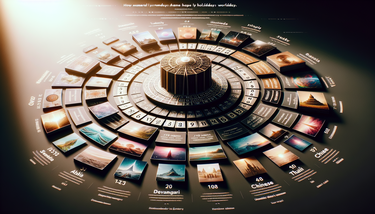
Since the dawn of time, man needed tools to measure time and help him in secular and religious matters. Questions like: When do we plant? When do we go to war? When should the tax collector show up? The dates of religious festivals and popular events all require a well-calibrated system and knowledge.
Our ancestors noticed the repetition in certain natural phenomena that comes in regular cycles. The phases of the moon, seasons and the locations of celestial objects, all functioned as bases for a human-made calendar. Calendars can generally be divided into three groups:
- Solar calendars
- Lunar calendars
- Lunisolar calendars
Solar Calendars
These are the calendars based on the Earth's rotation around the Sun, each cycle around the Sun equals to one year, and the year is divided into several seasons.
Egyptian Calendar

The oldest of these calendars is the Egyptian calendar, likely to be more than 5000 years old, and went through several stages and made several improvements until the year length became 365 days divided into three seasons with a duration of 120 days; each chapter contains four months of 30 days each. In addition to five intercalated days inserted to compensate for the calendar inaccuracy.
Julian Calendar

The Egyptian calendar has a prominent role as it was the basis for many of the calendars that came afterward, notably, the Julian evaluation that was introduced in Rome by Julius Caesar - in the first century BC - after learning about the Egyptian calendar, which is the basis for the current Gregorian calendar. The length of the year was 365.25, which is more accurate than the Egyptian calendar, this modification made it necessary to include an extra day every four years, and this was the first appearance of the leap year. The spread of the Julian calendar can be attributed to the Roman Empire, making it official after adopting it in 45 BC.
Gregorian Calendar

The third and most commonly used solar calendar is the Gregorian calendar, an amendment to the ancient Julian calendar. Scientists discovered that the time Earth travels a full circle around the Sun is slightly less than the 365.25 days suggested by the Julian calendar, which, through the accumulation of years, has started to drift. In 1582, Pope Gregory XIII ordered an amendment to the schedule in which the vernal equinox is aligned back to its date of 326 AD. The alterations included skipping ten days, making Thursday, October 4, 1582, followed by Friday, October 15, 1582. The calculation of the leap year was also changed, adding a day to every year divisible by four unless it is divisible by 100; except for multiples of 400.
Lunar Calendars

Scientists believe that the lunar calendars were the oldest calendars invented by man, and the earliest lunar calendar was likely to be 10,000 years old in Scotland. Since then, humans have continued to use lunar calendars to date and observe religious events, where many religions still use a lunar calendar to mark religious holidays.
Hijri calendar
The most famous lunar calendar currently in use is the Hijri calendar used by Muslims to determine their holidays and religious occasions. Hijri dates back to the year when the Prophet Muhammad migrated from Mecca to Medina. Nevertheless, the methods of calculation and the names of the months preceded the migration by about 150 years. Hijri calendar so far depends on the observance of the new moon at the beginning of the month, and the number of months of the year 12 months, making the Hijri year shorter than the solar year by about 11 days.
Lunisolar Calendars
These are the calendars that adopt a combination of moon phases to calculate months and the Earth's position on its orbit to calculate the year.
Hebrew Calendar

The oldest lunisolar calendars used so far are the Hebrew or Jewish calendar that starts from the year of the creation of the world 3761 BC according to the Bible. The length of the year is approximately 365.25 divided into twelve months of 29 days or 30 days with a month added every long calendar cycle -19 years- seven times.
Hindu Calendar
The Hindu calendar is another lunisolar calendar that has been in use for 3,000 years. The calendar has a cycle of 60 years, and each year has 12 lunar months with the addition of one month every five years.

 English
English  español
español  français
français  português
português  русский
русский  العربية
العربية  简体中文
简体中文 



